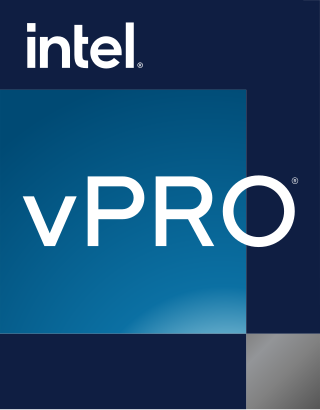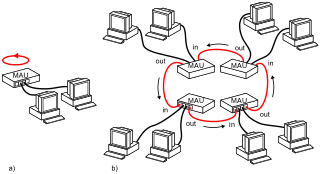Alert on LAN (AOL, sometimes AoL) is a 1998, IBM- and Intel-developed technology that allows for remote management and control of networked PCs. AOL requires a Wake on LAN adapter.
The main idea of AOL is to send warnings to remote administrators about different PC conditions using a LAN. These conditions include:
Alert on LAN 2 (AOL2) extends AOL to allow active PC management, including:

A motherboard is the main printed circuit board (PCB) in general-purpose computers and other expandable systems. It holds and allows communication between many of the crucial electronic components of a system, such as the central processing unit (CPU) and memory, and provides connectors for other peripherals. Unlike a backplane, a motherboard usually contains significant sub-systems, such as the central processor, the chipset's input/output and memory controllers, interface connectors, and other components integrated for general use.

Wake-on-LAN is an Ethernet or Token Ring computer networking standard that allows a computer to be turned on or awakened from sleep mode by a network message. It is based upon AMD's Magic Packet Technology, which was co-developed by AMD and Hewlett-Packard, following its proposal as a standard in 1995 – The standard saw quick adoption thereafter through IBM, Intel and others.
NetBIOS is an acronym for Network Basic Input/Output System. It provides services related to the session layer of the OSI model allowing applications on separate computers to communicate over a local area network. As strictly an API, NetBIOS is not a networking protocol. Operating systems of the 1980s ran NetBIOS over IEEE 802.2 and IPX/SPX using the NetBIOS Frames (NBF) and NetBIOS over IPX/SPX (NBX) protocols, respectively. In modern networks, NetBIOS normally runs over TCP/IP via the NetBIOS over TCP/IP (NBT) protocol. NetBIOS is also used for identifying system names in TCP/IP (Windows).

A KVM switch is a hardware device that allows a user to control multiple computers from one or more sets of keyboards, video monitors, and mouse.

The IBM RT PC is a family of workstation computers from IBM introduced in 1986. These were the first commercial computers from IBM that were based on a reduced instruction set computer (RISC) architecture. The RT PC uses IBM's proprietary ROMP microprocessor, which commercialized technologies pioneered by IBM Research's 801 experimental minicomputer. The RT PC runs three operating systems: AIX, the Academic Operating System (AOS), and Pick.
The Intelligent Platform Management Interface (IPMI) is a set of computer interface specifications for an autonomous computer subsystem that provides management and monitoring capabilities independently of the host system's CPU, firmware and operating system. IPMI defines a set of interfaces used by system administrators for out-of-band management of computer systems and monitoring of their operation. For example, IPMI provides a way to manage a computer that may be powered off or otherwise unresponsive by using a network connection to the hardware rather than to an operating system or login shell. Another use case may be installing a custom operating system remotely. Without IPMI, installing a custom operating system may require an administrator to be physically present near the computer, insert a DVD or a USB flash drive containing the OS installer and complete the installation process using a monitor and a keyboard. Using IPMI, an administrator can mount an ISO image, simulate an installer DVD, and perform the installation remotely.

Sleep mode is a low power mode for electronic devices such as computers, televisions, and remote controlled devices. These modes save significantly on electrical consumption compared to leaving a device fully on and, upon resume, allow the user to avoid having to reissue instructions or to wait for a machine to boot. Many devices signify this power mode with a pulsed or red colored LED power light.
IBM Storage Protect is a data protection platform that gives enterprises a single point of control and administration for backup and recovery. It is the flagship product in the IBM Spectrum Protect family.

Intel vPro technology is an umbrella marketing term used by Intel for a large collection of computer hardware technologies, including VT-x, VT-d, Trusted Execution Technology (TXT), and Intel Active Management Technology (AMT). When the vPro brand was launched, it was identified primarily with AMT, thus some journalists still consider AMT to be the essence of vPro.

In systems management, out-of-band management is a process for accessing and managing devices and infrastructure at remote locations through a separate management plane from the production network. OOB allows a system administrator to monitor and manage servers and other network-attached equipment by remote control regardless of whether the machine is powered on or whether an OS is installed or functional. It is contrasted to in-band management which requires the managed systems to be powered on and available over their operating system's networking facilities.

Token Ring is a physical and data link layer computer networking technology used to build local area networks. It was introduced by IBM in 1984, and standardized in 1989 as IEEE 802.5. It uses a special three-byte frame called a token that is passed around a logical ring of workstations or servers. This token passing is a channel access method providing fair access for all stations, and eliminating the collisions of contention-based access methods.
Network booting, shortened netboot, is the process of booting a computer from a network rather than a local drive. This method of booting can be used by routers, diskless workstations and centrally managed computers such as public computers at libraries and schools.
RM Nimbus was a range of personal computers from British company Research Machines sold from 1985 until the early 1990s, after which the designation Nimbus was discontinued. The first of these computers, the RM Nimbus PC-186, was not IBM PC compatible, but its successors the PC-286 and PC-386 were. RM computers were predominantly sold to schools and colleges in the United Kingdom for use as LAN workstations in classrooms.
In computing, the term remote desktop refers to a software- or operating system feature that allows a personal computer's desktop environment to be run remotely from one system, while being displayed on a separate client device. Remote desktop applications have varying features. Some allow attaching to an existing user's session and "remote controlling", either displaying the remote control session or blanking the screen. Taking over a desktop remotely is a form of remote administration.
AOL is an American company that invests in brands and web sites.

Intel Active Management Technology (AMT) is hardware and firmware for remote out-of-band management of select business computers, running on the Intel Management Engine, a microprocessor subsystem not exposed to the user, intended for monitoring, maintenance, updating, and repairing systems. Out-of-band (OOB) or hardware-based management is different from software-based management and software management agents.
Host Embedded Controller Interface (HECI) is technology introduced in 2006 used for Active Management Technology (AMT) in Intel chipsets that support Core 2 Duo microprocessors.

A storage area network (SAN) or storage network is a computer network which provides access to consolidated, block-level data storage. SANs are primarily used to access data storage devices, such as disk arrays and tape libraries from servers so that the devices appear to the operating system as direct-attached storage. A SAN typically is a dedicated network of storage devices not accessible through the local area network (LAN).
In computing, rebooting is the process by which a running computer system is restarted, either intentionally or unintentionally. Reboots can be either a cold reboot in which the power to the system is physically turned off and back on again ; or a warm reboot in which the system restarts while still powered up. The term restart is used to refer to a reboot when the operating system closes all programs and finalizes all pending input and output operations before initiating a soft reboot.
MS-Net, sometimes stylized as MS-NET, was a network operating system sold by Microsoft in the 1980s, the earliest days of local area networking.